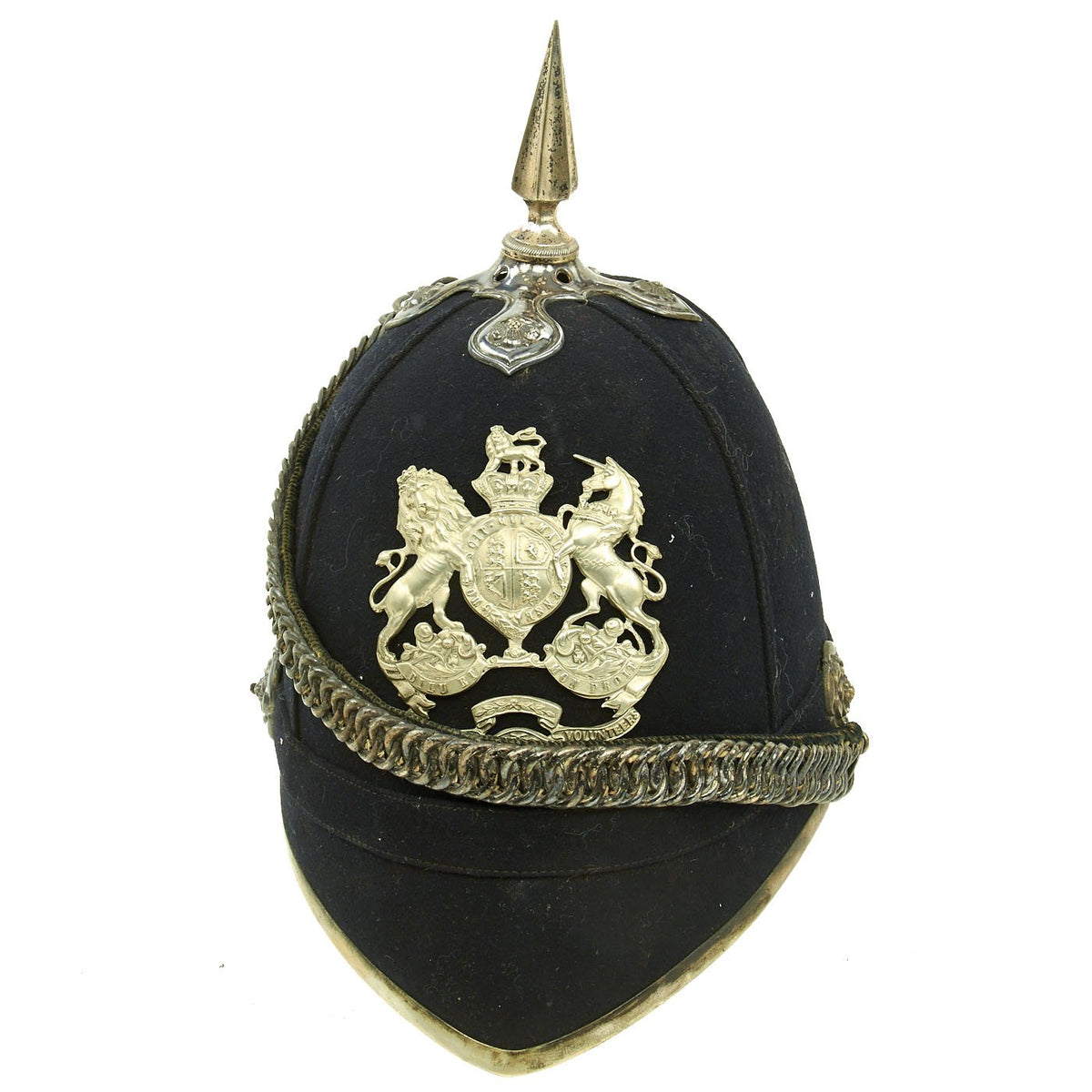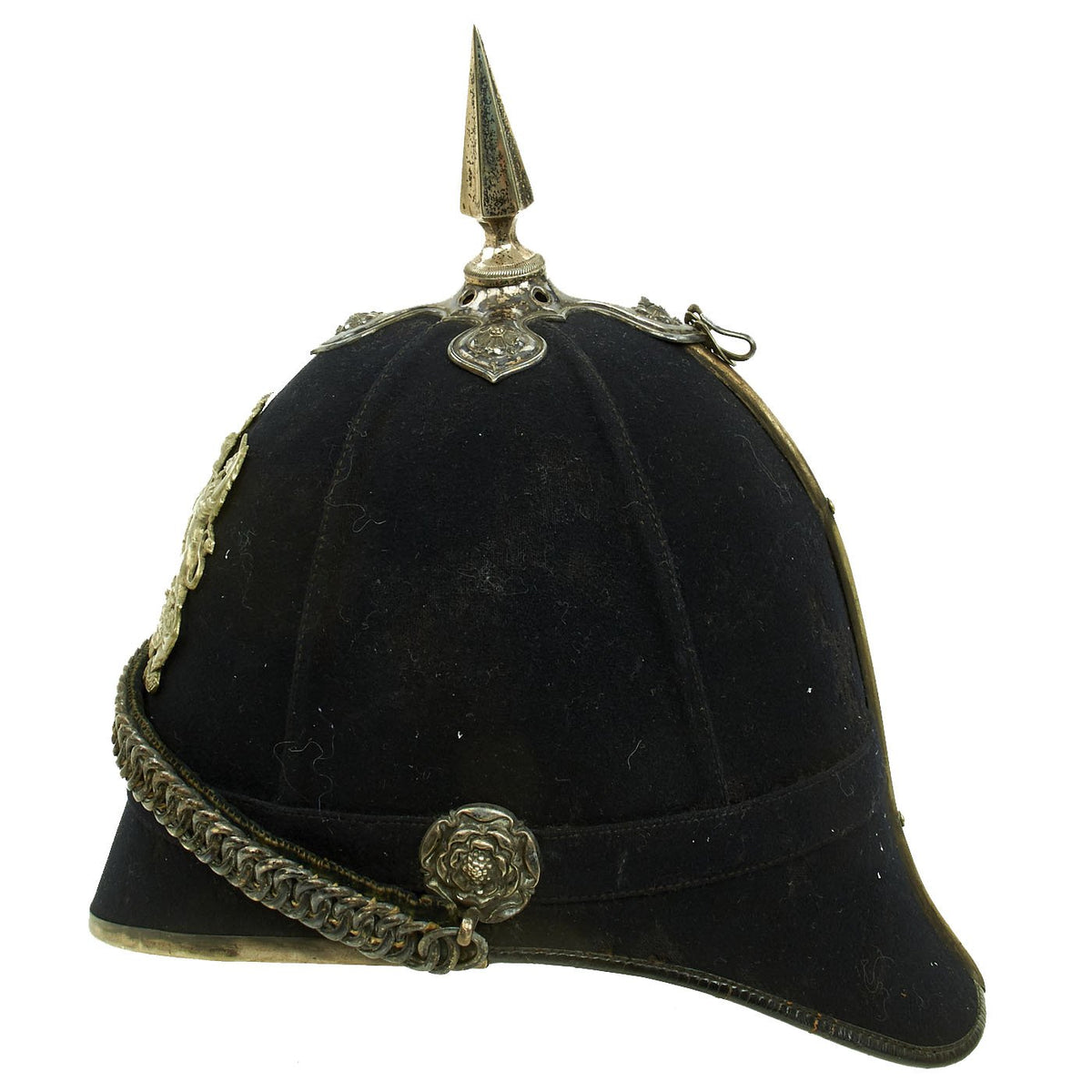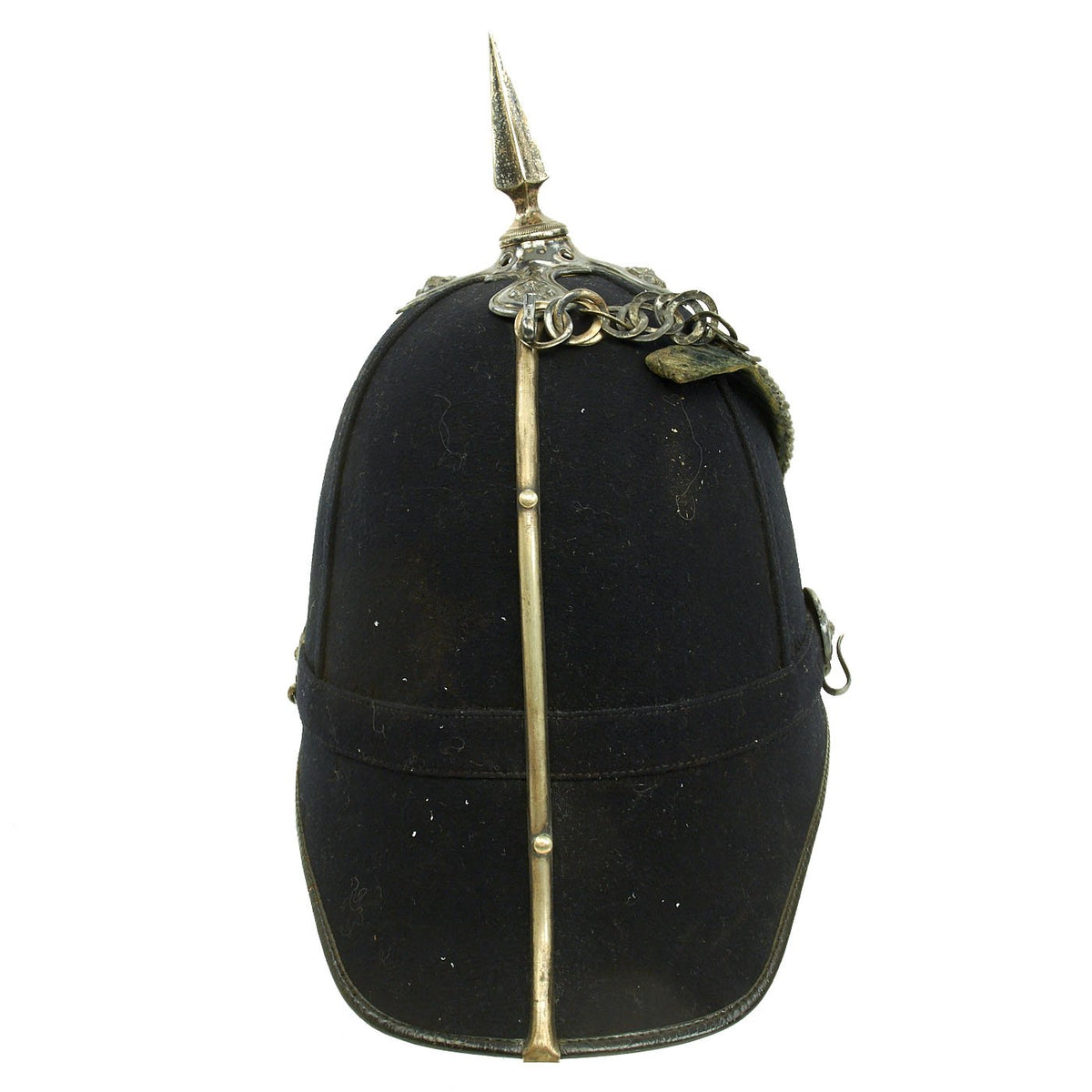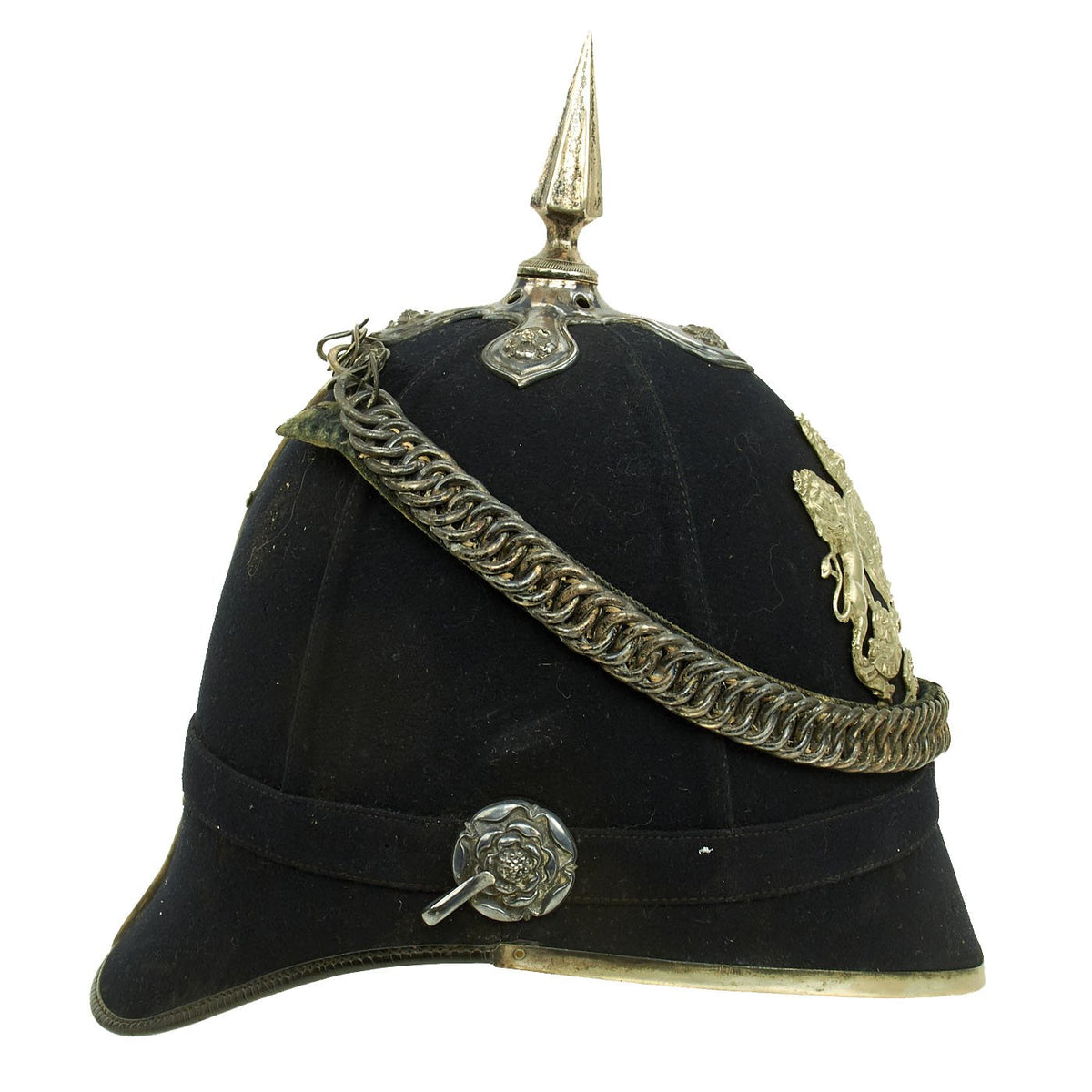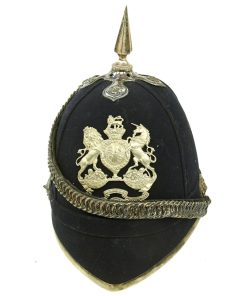Original British Victorian Royal Engineer Volunteer’s Blue Cloth Spiked Helmet by Harman & Co. Original Items
$ 595,00 $ 178,50
Original Item: Only One Available. You may remember Staley Baker, in his magnificent role in the Film ZULU as Lieutenant Chard. Well he was a ROYAL ENGINEER. Michael Caine and the others were of the 24th Foot, known as the “SOUTH WALES BORDERS”.
This is an excellent condition British Engineer Volunteer’s spiked Blue Cloth helmet, and is typical of those in use during the late VICTORIAN era, the time of the British Empire. It comes complete with its original top fitting, removable spike, and metal “ring” chin strap, attached to the back of the spike base. The chin strap lugs and spike base ends are all properly adorned with embossed roses. This helmet has all white metal or silver plated mounts used on “Volunteer” helmets, as opposed to the gilt brass of regular forces.
The front of the helmet has the correct silver volunteer’s regimental helmet plate, under a QUEEN’S CROWN, with the Motto HONI SOIT QUI MAL Y PENSE (Evil to him who evil thinks) in a circle. Under this is a banner reading DEIU ET MON DROIT (God and My Right), the motto of the British Royal Family. Below this is another banner, reading ENGINEER VOLUNTEERS. On non-volunteers, this bottom banner would instead read Ubique and Quo Fas et Gloria Ducunt (“Everywhere” and “Where Right And Glory Lead”).
The interior of the helmet still has its correct leather and fabric liner, which does show some degradation from age and use. There is some tearing of the leather and fabric, as well as some seam pulling. The top vent of the helmet has a manufacture’s label reading HARMAN & CO. / CHATHAM.
This is truly an excellent example of this type of helmet, and we rarely have offerings this attractive. Ready to add to your collection and display!
The Royal Engineer Volunteers:
The Corps of Royal Engineers, usually just called the Royal Engineers (RE), and commonly known as the Sappers, is a corps of the British Army. It provides military engineering and other technical support to the British Armed Forces and is headed by the Chief Royal Engineer. The Regimental Headquarters and the Royal School of Military Engineering are in Chatham in Kent, England. The corps is divided into several regiments, barracked at various places in the United Kingdom and around the world.
The re-organisation of the British military that began in the mid-Nineteenth Century and stretched over several decades included the reconstitution of the Militia, the raising of the Volunteer Force, and the ever-closer organisation of the part-time forces with the regular army.[5] The old Militia had been an infantry force, other than the occasional employment of Militiamen to man artillery defenses and other roles on an emergency basis. This changed in 1861, with the conversion of some units to artillery roles. Militia and Volunteer Engineering companies were also created, beginning with the conversion of the militia of Anglesey and Monmouthshire to engineers in 1877. The Militia and Volunteer Force engineers supported the regular Royal Engineers in a variety of roles, including operating the boats required to tend the submarine mine defenses that protected harbors in Britain and its empire. These included a submarine mining militia company that was authorized for Bermuda in 1892, but never raised, and the Bermuda Volunteer Engineers that wore Royal Engineers uniforms and replaced the regular Royal Engineers companies withdrawn from the Bermuda Garrison in 1928. The various part-time reserve forces were amalgamated into the Territorial Force in 1908, which was retitled the Territorial Army after the First World War, and the Army Reserve in 2014.
Fast Shipping with Professional Packaging
Thanks to our longstanding association with UPS FedEx DHL, and other major international carriers, we are able to provide a range of shipping options. Our warehouse staff is expertly trained and will wrap your products according to our exact and precise specifications. Prior to shipping, your goods will be thoroughly examined and securely secured. We ship to thousands clients each day across multiple countries. This shows how we're dedicated to be the largest retailer on the internet. Warehouses and distribution centres can be located throughout Europe as well as the USA.
Note: Orders with more than one item will be assigned a processing date depending on the item.
Before shipping before shipping, we'll conduct a thorough inspection of the items you have ordered. Today, the majority of orders will be delivered within 48 hours. The delivery time will be between 3-7 days.
Returns
The stock is dynamic and we cannot completely manage it because multiple stakeholders are involved, including our factory and warehouse. So the actual stock may alter at any time. It's possible that you may not receive your order once the order has been made.
Our policy is valid for a period of 30 days. If you don't receive the product within 30 days, we are not able to issue a refund or an exchange.
You can only return an item if it is unused and in the same state as the day you received it. You must have the item in its original packaging.
Related products
Uncategorized
Uncategorized
Uncategorized
Uncategorized
Uncategorized
Uncategorized
Uncategorized
Uncategorized
Uncategorized
Uncategorized
Uncategorized
Band of Brothers ORIGINAL GERMAN WWII Le. F.H. 18 10.5cm ARTILLERY PIECE Original Items
Uncategorized
Uncategorized
Uncategorized
Armoured Fighting Vehicles of the World: AFVs of World War One (Hardcover Book) New Made Items
Uncategorized
Australian WWII Owen MK1 Machine Carbine SMG Custom Fabricated Replica with Sling Original Items
Uncategorized
Uncategorized
